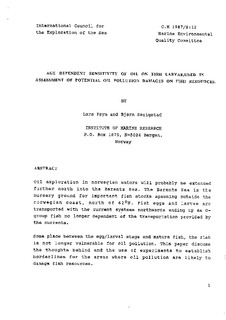| dc.contributor.author | Føyn, Lars | |
| dc.contributor.author | Serigstad, Bjørn | |
| dc.date.accessioned | 2012-07-05T06:25:58Z | |
| dc.date.available | 2012-07-05T06:25:58Z | |
| dc.date.issued | 1987 | |
| dc.identifier.citation | This report is not to be cited without prior reference to the authors | no_NO |
| dc.identifier.uri | http://hdl.handle.net/11250/104292 | |
| dc.description.abstract | Oil exploration in Norwegian waters will probably be extended
further north into the Barents Sea. The Barents Sea is the
nursery ground for important fish stocks spawning outside the
norwegian coast, north of 62°N. Fish eggs and larvae are
transported with the current systems northwards ending up as 0-group
fish no longer dependent of the transportation provided by
the currents.
Some place between the egg/larval stage and mature fish, the fish
is not longer vulnerable for oil pollution. This paper discuss
the thoughts behind and the use of experiments to establish
borderlines for the areas where oil pollution are likely to
damage fish resources. | no_NO |
| dc.language.iso | eng | no_NO |
| dc.publisher | ICES | no_NO |
| dc.relation.ispartofseries | ICES CM Documents;1987/E:12 | |
| dc.subject | oil activity | no_NO |
| dc.subject | oljeaktivitet | no_NO |
| dc.subject | pollution | no_NO |
| dc.subject | forurensning | no_NO |
| dc.title | Age dependent sensitivity of oil on fish larvae, used in assessment of potential oil pollution damages on fish resources | no_NO |
| dc.type | Working paper | no_NO |
| dc.subject.nsi | VDP::Agriculture and fishery disciplines: 900::Fisheries science: 920::Resource biology: 921 | no_NO |
| dc.subject.nsi | VDP::Mathematics and natural science: 400::Zoology and botany: 480::Ecotoxicology: 489 | no_NO |
| dc.source.pagenumber | 16 s. | no_NO |
